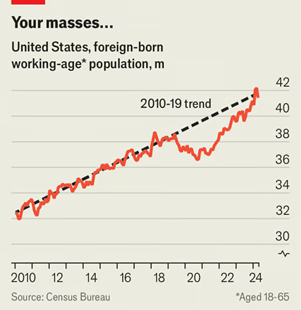The Daily Escape:

Rustic barn at sunset, Sherman, CT – June 2024 photo by Dave King Photography
Tonight’s presidential debate is sure to include words and misinformation about US immigration, along with heaps of emotion. Trump and the GOP have made their opposition to immigration a defining political message. If he’s elected again, he wants to round up millions of the undocumented, then detain and deport them. Comments about “s**thole countries,” and nations sending “rapists” and “murderers” to the border were hallmarks of Trump’s first term. He’s built on that this time around.
Biden OTOH, has taken two executive actions on immigration recently. First, it was restricting the number of migrants who can request asylum in a given day. And then he announced a new measure to shield unauthorized immigrants who are married to US citizens from deportation.
Biden’s moves offer something for voters who think border enforcement is too lenient as well as for those who support helping immigrants who live in the US illegally. Since Biden took office, he’s used a mix of policies to restrict illegal immigration and offer help to people already in the country.
Republicans say Biden’s border policies have made the southern border like Swiss cheese. Republicans think of immigration as a problem of enforcement and domestic security (or at least the great political hay they can make of harping about enforcement and security).
We all know that despite the theater, America’s immigration system needs reform in areas including refugee status, skilled-worker visas, and new immigration quotas that have been out of date for decades.
What’s little known is that while the surge of illegal migration has soaked up America’s and the Department of Homeland Security’s attention and resources, The Economist says that legal immigration has rebounded.
Under Trump, we had the longest continuous decline in new green cards issued since the 1990s. The number of refugees admitted annually fell to its lowest level in the resettlement program’s history. Denial rates for skilled-worker visas rocketed. Later, the Covid pandemic closed consulates abroad.
But legal migration is on the rise again. Nearly 1.2 million green cards were issued in the FY 2023, a 68% increase from 2020. The government is projected to resettle at least 90,000 refugees in 2024, far more than the 11,000 or so settled during the pandemic.
Non-immigrant visas, the kind that temporary workers and students get, have also grown. The H-1B lottery system, which allots visas to high-skilled, mostly tech, workers, is a lottery in which hundreds of thousands of applicants compete for just 85,000 spots. Many workers apply several times in the hope of improving their chances of being selected.
Although more students are coming to study in America, many more are also being denied visas. The same factors encouraging border crossings ̶ a hot labor market, violence and instability at home, and a more welcoming administration ̶ are convincing young people abroad to try to get their education in America.
What has all this meant for the workforce? At its peak in 2021, the US had a shortfall of foreign-born workers of about two million people. That’s now disappeared, partly due to the people who came across the southern border and found work. But there also has been a rebound of college-educated legal migrants. Here’s a chart from The Economist:

Today, the US has returned to the trend line of the 2010’s for foreign-born workforce. Importantly, about 45% of recent immigrants have a college degree, compared with 38% of native-born Americans and 33% of those who arrived in the 1990s.
All of this is in spite of the creaky immigration system itself. Congress has repeatedly failed to create new legal pathways for migrants, to increase caps for limited visas and to make the system more responsive to the needs of America’s economy.
The result is a monumental backlog for handling asylum cases at the southern border, and for processing legal immigrants and green card applicants. This means it takes years to adjudicate an asylum claim in the US, and it means long waiting times at our overseas consulates.
Importantly, Americans do not share the Republican view of not allowing immigration reform. While most Americans support more deportations and the border wall, they approve of immigration overall. Some 61% of registered voters surveyed by Pew in April maintain that America’s openness to people from elsewhere is essential to its national character.
But it’s an election year. So it’s doubtful that any of these facts will be on display at the debate. And as Hillary Clinton said in the NYT:
“It is a waste of time to try to refute…Trump’s arguments like in a normal debate. It’s nearly impossible to identify what his arguments even are. He starts with nonsense and then digresses into blather. This has gotten only worse in the years since we debated. I was not surprised that after a recent meeting, several chief executives said that Mr. Trump, as one journalist described it, ‘could not keep a straight thought’ and was ‘all over the map.’”
What’s the best we can hope for from the debate? That CNN’s moderators rise above the usual script, that they avoid normalizing the crackpot who’s using his nonsense, deceit and lies to be seen as equal to his opponent. If they check the crackpot, there’s a chance that the debate won’t be a train wreck caused by what we’ve come to see as “poor moderation.”
Will CNN check the crackpot, or will we be forced to again thread our way through the cacophony?

Immigration policy is driven by ideology and lies. On the left we see continuing arguments that there are no illegal people…. (so ok, but how does that change how we address immigration) and on the right we see complete denial that people keep looking for low cost labor – and we see this in immigration cases brought in meat processing plants in red states (for example). Dems in office are willing to change but on the right the screwballs are leading the unwillingness to change.